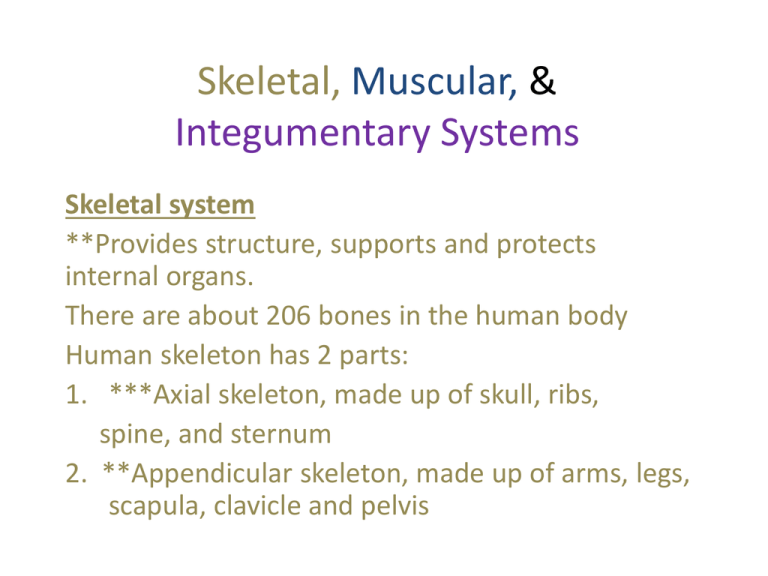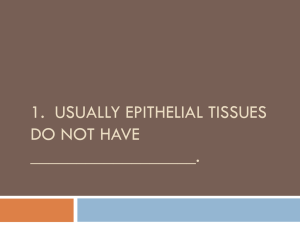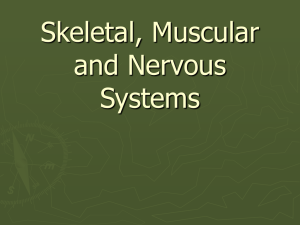Skeletal, Muscular, & Integumentary Systems
advertisement

Skeletal, Muscular, & Integumentary Systems Skeletal system **Provides structure, supports and protects internal organs. There are about 206 bones in the human body Human skeleton has 2 parts: 1. ***Axial skeleton, made up of skull, ribs, spine, and sternum 2. **Appendicular skeleton, made up of arms, legs, scapula, clavicle and pelvis • **Bone Marrow where blood cells are produced Soft tissue inside bones • Injury/Repair A crack or break is called a fracture (about 6wks to heal) • Osteocytes A bone cell • Bone development Most bones develop from cartilage, through a process of ossification. However the skull develops directly into hard bone Without forming cartilage first. • *In early development, bone tissue is made up mainly of groups of osteocytes Bone elongation • **Takes place near the ends of long bones in an area called the epiphyseal plate • Epiphyseal plate is made up of cartilage cells that divide and form column, pushing old cells toward middle of the bone. As the older cells die, they are replaced by new bone cells. This process continues until all the cartilage has been replaced by bone in the epiphyseal plate. Order of structures that make up a bone (outer – inner) • *Periosteum, compact bone, spongy bone, bone marrow • **Periosteum is a tough membrane covering bone Bone Health • Calcium is very important • Stress to bones is obtained through weight bearing exercise Bones to Know • Skull Occipital Parietal Frontal Temporal • Face mandible Trunk Sternum Bones to Know • Skull Occipital Parietal Frontal Temporal • Face Maxilla Mandible • The Chest clavicle Sternum Ribs Scapula • The Arm Humerus Ulna Radius • The Hand Phalanges Metacarpals Carpals • The Leg Pelvis Femur Petella Tibia Fibula • The Foot Phalanges Metatarsals Tarsals • The Vertebrae Cervial Atlas Axis • Quiz on Bones Joints • The place where 2 bones meet is called a joint • 3 major types of joints 1. fixed 2. semimovable 3. movable Joint Description Location Fixed Prevent movement skull **Semimovable Limit movement Vertebral column, rib cage Allow for a wide All other joints in body range of motion. *Elbow, finger knuckle, toe knuckle Types of movable *Hinge not wrist (allows you to move joints: up & down, like a hinge door) *shoulder (allows up & down Ball and socket movement & rotation) 2 vertebrae of your spine base of each thumb Pivot small bones in foot (allow bones to Saddle slide over one another, like when Gliding you flex your foot when you walk) Movable Joint structure • **Ligament Tough band of connective tissue that hold the bones of the joint in place in all movable joints • Synovial fluid Lubricating substance between joints 2 types of arthritis 1. **Rheumatoid arthritis The joints become inflamed, swollen, stiff and deformed. 2. Osteoarthritis Degenerative joint disease. The cartilage covering the surface of the bone becomes thinner and rougher. Resulting in bone surfaces rubbing against each other. • **Extensor straightens a joint • **Flexor bonds a joint • So bicep is the flexor and tricep is the extensor (flexes the elbow, while the tricep extends) • Quiz on Joints Body Tissue • Tissue: A group of similar cells working together to perform a certain function Muscle tissue • Made up of cells that can contract (facial tissue) • 3 types of muscle tissue 1. skeletal 2. smooth 3. cardiac • **Muscle moves bones by pulling them Muscle tissue type Skeletal muscle location Moves bones in trunk, limbs, and face *Smooth muscle Handles body functions that you cannot control consciously (involuntary) like the digestive system **Cardiac muscle Found in your heart. **Pumps blood through your body Neurons • **Nervous tissue contains cells that receive and transmit messages called neurons (electrical impulses) Body cavities • The human body has 5 main cavities: Located in the upper part of the body are: 1. Cranial cavity: contains the brain 2. Spinal cavity: contains the spine Two cavities are located in the trunk of the body separated by the diaphragm 3. Thoracic cavity: contains the heart, esophagus, and organs of the respiratory system 4. Abdominal cavity: contains the digestive system 5. **Pelvic cavity is the lowest cavity containing the organs of the reproductive and excretory systems Homework Questions Pg 910 #1, 2 pg 916 #1,5,6 Muscular system • Muscular system accounts for one third of your weight muscle type Skeletal Smooth Cardiac Description/job Voluntary, moves parts of body Involuntary Has characteristics of both skeletal and smooth location Limbs, trunk, face Stomach, intestines, blood vessels, and other internal organs heart Muscular movement • **Tendon: Attaches muscle to bone Origin: Point where muscle attaches to stationary bone • Insertion: Point where muscle attaches to moving bone Example: bicep muscle radius moves up (bending at the elbow) radius is insertion, scapula doesn’t move so it’s the origin • Most skeletal muscles are arranged in opposing pairs. • One muscle moves limb one direction and the opposing muscle move it the other direction • **Flexor bends a joint • **Extensor straightens a joint • So bicep is the flexor and tricep is the extensor or the opposng muscle(flexes the elbow, while the tricep extends) • *Energy for muscle contraction comes from glycogen, glucose, and ATP • **When a skeletal muscle contracts the sarcomeres shorten • **Components of muscle tissue in order smallest to largest: Actin and myosin filaments, sarcomere, myofibril • *When a sarcomere is fully contracted actin and myosin completely overlap each other • **Muscle fatigue and soreness may result from ATP consumption exceeds ATP production Homework • Pg 922 #1, 2, 5, 6, 7 • Worksheet: muscular system • LABS: horsepower lab weight training Integumentary • Made up of skin, hair, nails • *It protects , eliminates waste, regulates body temperature (homeostatis), and helps retain body fluids • **Skin contains exocrine glands, sweat glands, and oil glands Skin • Our skin protects, moistens. • Blood vessels dilate to cool and constrict to conserve heat. • Sweat glands help rid the body of wastes products. 4 tissue types in the skin • • • • muscular epithelial nerve connective Layers of cells • Outer most layer of the epidermis = squamous epithelial (flat and dead cells). • *Main components of epidermis are connective tissue and epithelial tissue • *Hair and nails are derived from cells in the epidermis • Germinative cells are below and reproduce very fast. • Psoriasis is a condition where the epidermal cells are being produced and discarded too fast. Dermis • Inner layer made up of living cells and specialized structure like sensory neurons, blood vessels, muscle fibers, hair follicles and glands • *Blood vessels and sweat glands help regulate body temperature • Carotenoids cause the yellow or olive coloring. Where hemoglobin causes a reddish or pinkish color. • Subcutaneous: Fatty loose Connective tissue that binds skin to organs • Acts as an insulator and shock absorber Glands • Exocrine glands are found in the skin • The main exocrine glands are the sweat glands and the oil glands • Keratin is a tough waterproof protein fiver made from the cells cytoplasm. • Nails have undergone more keratinization than other epidermal cells. • **Both nails and hair contain keratin • The light region at the base of your fingernail is where new epithelial cells are produced. • Melanin are specialized cells that produce a pigment responsible for skin color. • Freckles are caused by an uneven distribution of melanin. Hair • Shaft is made from epidermal cells that fully keratinize or fill with insoluble protein. • These epidermal cells that line the hair root reproduce fast and then die and push up thru the follicle. • Hair color determined by melanin and other pigments in the hair follicle. • White hair is believed to be white because the production of melanin is shut off. • *The skin, the lymph nodes and white blood cells are play a part in the immune system, but NOT the heart! • *The nervous system consists of the brain, spinal cord, and sense organs • *Cell is to tissue as tissue is to organ • **The function of the respiratory system is to control gas exchange between the blood and the lungs







